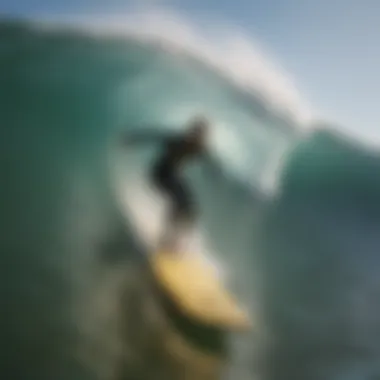Exploring the Boardsports Culture of California


Intro
California, often seen as the heart of numerous boardsports, has an astonishingly rich landscape that fosters a diverse array of activities like surfing, skateboarding, snowboarding, and more. From the roaring waves of the Pacific Ocean at Malibu to the iconic skate parks of San Francisco, this state is synonymous with boardsport culture. The warmth of the sun, the sound of the surf, and the thrill of carving asphalt define California's unique identity, attracting both weekend warriors and seasoned pros alike.
What makes boardsports in California not just a pastime but a vibrant culture is their deep-rooted community connections. These activities are more than mere sports; they are ways of life, creating bonds among participants who share a passion for adventure and the great outdoors. As we dive deeper into this article, we will uncover essential techniques tailored to both newcomers eager to learn and the veterans striving to hone their skills.
Exploring the nuances of boardsports doesn’t just stop at technique, though. Choosing the right equipment can make or break your experience, and knowing what to look for is crucial. This comprehensive overview seeks to navigate through these elements, shedding light on everything from essential gear to environmental concerns tied to the practices of surfing and skating.
As we embark on this journey through California's boardsports scene, we aim to weave together the historical context and contemporary trends, presenting an insightful narrative that captures the essence of this exhilarating lifestyle.
Preamble to Boardsports
Boardsports encompass a wide range of activities that involve riding on some type of board, usually across varying terrains such as water, land, or snow. These activities, which include surfing, skateboarding, and snowboarding, have defined not just physical engagement but also cultural and social interactions, especially in a context as vibrant as California. With the state's diverse landscapes—from its pristine beaches to mountainous regions—boardsports have morphed into symbols of lifestyle, community, and even rebellion.
Understanding the essence of boardsports offers numerous benefits. For enthusiasts, knowing the broader significance provides a richer perspective of their passion. For newcomers, a well-rounded introduction can be a gateway to a life filled with adventure. Moreover, exploring this dynamic culture shines a light on the communal values that often accompany these sports, enabling individuals to feel connected to a wider network of like-minded people.
Of importance is the fact that boardsports are not merely recreational. They serve as platforms for personal expression, competition, and environmental awareness. Participants often share values of respect for nature and sustainable practices, shaping how these sports are approached. Surf culture, for instance, emphasizes harmony with the ocean, while skateboarding often challenges urban environments. Each activity brings its own culture, further enriched by California's unique lifestyle.
Defining Boardsports
At its core, boardsports are defined by the fundamental act of riding upon a board. The category spans a variety of activities, each with its own nuances and appeal. Surfing involves gliding on waves with a surfboard, harnessing the power of water. Skateboarding, on the other hand, revolves around maneuvering on streets or parks using a specially designed board with wheels. Snowboarding takes place on snowy slopes, capturing the thrill that winter carries.
However, defining boardsports extends beyond technical skill. It speaks to the lifestyle that participants cultivate. For many, engaging in these activities reflects personal values such as freedom, creativity, and individuality. Whether it's the early morning waves beckoning surfers, the camaraderie of skaters at a local park, or the adrenaline rush of a snowy mountain descent, boardsports have a profound effect on personal identities. They foster not just physical ability but also emotional resilience, pushing individuals to overcome challenges and celebrate victories.
Historical Context in California
California holds a pivotal place in the history of boardsports, serving not only as a backdrop but also as a birthplace for many iconic movements. Surfing was popularized in California during the early 20th century, thanks to the influence of Hawaiian culture brought by Duke Kahanamoku. As surfers began to ride the swells off the coast, they introduced a lifestyle that entwined surfing with a laid-back ethos. Over time, surf culture became synonymous with coastal living, attracting enthusiasts from around the globe.
The skateboarding scene began to take shape in the 1950s, largely as a way for surfers to practice their moves on land. Recognized quickly for its rebellious spirit, skateboarding evolved into a standalone sport by the 1970s. California's sunny weather, coupled with a growing network of skate parks, further fueled its popularity. From the emergence of innovative tricks to the establishment of competitions, the state fostered a creative breeding ground for skateboarders.
Snowboarding gained traction in the 1980s, when slopes were introduced to new board designs and techniques. With the Sierra Nevada mountain range providing a perfect playground, California became a hotspot for snow sports, integrating elements of both surfing and skateboarding into a winter landscape. Thus, it's evident that boardsports in California are deeply rooted in a complex history marked by innovation, cultural exchange, and distinct lifestyles.
The Surfing Culture
Surfing is more than just a sport in California; it's a way of life that weaves into the fabric of coastal communities. This section explores how surfing shapes identity, boosts local economies, and influences youth culture across the Golden State. A deep dive into this topic allows us to appreciate its rich tradition and ongoing evolution.
Major Surf Spots
Malibu
Malibu, often revered as the heart of surfing in California, boasts an iconic stretch of coastline that's famous even beyond the USA. The waves here are legendary, particularly at the renowned Surfrider Beach. What makes Malibu a standout is not just its beauty but its ability to cater to both amateur surfers and seasoned pros.
The turquoise water and consistent swells make it a go-to for many. A significant aspect of Malibu is its accessibility; close to major urban centers, it draws in countless surf enthusiasts year-round. However, the crowded beaches can pose challenges for surfers seeking their own space on the waves. Still, the community spirit and vibe here are hard to beat.
Pipeline
Pipeline is synonymous with power and precision. Known for its massive waves, it presents challenges that truly test a surfer's skill. The waves here break over a reef, creating a hollow tube that’s both thrilling and intimidating. The environment demands respect from those who dare to ride it.
For experts, it’s a playground, but for beginners, it can be overwhelming. Many notable surfing competitions take place here, adding to its allure. Surfing Pipeline is seen as a rite of passage among elite surfers, which feeds into its reputation as one of the most essential surf spots in California.
Huntington Beach
Huntington Beach, famed as "Surf City USA," offers something for everyone. Families flock here for the sandy beaches, while surfers revel in the consistent wave conditions. What sets this beach apart is its vibrant surf culture, evident in the surf shops, schools, and annual events centered around surfing.
The local community prides itself on fostering a welcoming atmosphere where newbies can learn from veterans. However, as surf schools flourish, so do the crowds, leading to potential conflicts over wave priority. Yet, the beach has a unique charm that captures the essence of California surfing.
Competitions and Events
US Open of Surfing
The US Open of Surfing is a premier event that showcases the best talent in the sport while drawing crowds from around the world. Held annually in Huntington Beach, it’s more than just a competition; it’s a cultural festival that celebrates the surfing lifestyle. The event features live music, art installations, and opportunities to engage with surf culture at its finest.
What makes this event significant is its role in shaping careers. Many surfers use the platform to launch their professional journeys. However, the scale of the event can sometimes overshadow the sport itself, diluting the intimate community vibe often found in smaller contests.
World Surf League
The World Surf League represents the pinnacle of competitive surfing, providing a global stage for the best surfers to showcase their skills. Featuring multiple events throughout the year, this league significantly impacts how surfing is viewed worldwide. Surf enthusiasts eagerly follow the league, making it a crucial aspect of the surfing culture.
While it enhances visibility for the sport, the commercialization can make it seem distant from the grassroots, authentic surfing experiences. Nonetheless, for many aspiring surfers, competing in these events remains a dream worth chasing.
Influential Surfers


Kelly Slater
Kelly Slater stands as a monumental figure in the surfing world. Known for his unmatched talent and competitive spirit, his achievements have inspired countless surfers. As a multiple-time world champion, Slater's influence stretches beyond the water; he has become a brand in his own right, advocating for ocean conservation and sustainable practices.
His ability to adapt and evolve with the sport keeps him relevant, although some debate whether his prominence overshadows emerging talent. Regardless, his legacy is intertwined with the very essence of professional surfing.
Lisa Anderson
Lisa Anderson broke barriers in the male-dominated surfing scene, emerging as a fierce competitor and a role model for female surfers. Her accomplishments, including multiple world championships, have paved the way for many women in the sport.
What’s distinct about Anderson is not just her records but her influence on community-building initiatives for female surfers. Yet, even as she champions women's surfing, the struggle for equal recognition within the sport remains a pressing issue. Her efforts continue to inspire the next generation, reminding everyone that surfing knows no gender.
Skateboarding Evolution
Skateboarding has undergone a remarkable transformation in California, growing from a simple pastime into a thriving cultural phenomenon. This evolution is crucial to understanding the broader movements within boardsports. Starting as an offshoot of surfing, it has carved its own identity shaped by creativity, innovation, and community. Today, skateboarding is not just about tricks and flips; it represents a way of life for many enthusiasts who find freedom and expression through their boards. The importance of this evolution lies not only in the history of the sport but also in its impact on lifestyle choices, youth culture, and urban landscapes.
From Street to Park
The shift from street skating to skate parks marks a significant chapter in skateboarding's story. Initially, skaters showed ingenuity, turning curbs, stairs, and parking lots into their playgrounds. This grassroots movement was raw, often pushing the edges of legality and societal acceptance. However, as skateboarding gained popularity, the need for dedicated spaces became evident.
Skate parks began to emerge as safe havens for enthusiasts, providing a controlled environment for practicing skills and tricks without the risk of confrontation with local authorities. The evolution from street to park indicates an acceptance of skateboarding into mainstream culture and a response from communities to provide outlets for young talent. It showcases how skateboarding adapted to the times, prioritizing safety while still fostering the rebellious spirit that defines it.
Iconic Skate Parks
Venice Beach
Venice Beach is synonymous with skate culture. Its vibrant atmosphere draws skaters from around the globe. One main characteristic is its famous skate park, known for its unique bowl-shaped features and often bustling with activity. The free-spirited vibe of Venice makes it a beneficial choice for both seasoned skaters and newcomers alike. The park’s location along the picturesque boardwalk adds to its charm, inviting passersby to watch or join in.
The unique feature of Venice Beach lies in its artistic expression, often showcased through sidewalk graffiti and surrounding murals. However, the popularity can also be its downside; during peak times, it may feel overcrowded, challenging both competitive and casual skaters to find their rhythm among masses. Yet, the experience of skating at such an iconic spot, where history and culture intertwine, is invaluable.
Pier Park
On the flip side, Pier Park in Ventura offers a different kind of skating environment. Known for its family-friendly atmosphere, it serves as a community hub that welcomes skaters of all ages and skill levels. The park features a well-designed layout with various ramps and obstacles, tailored for different skating abilities.
A key characteristic of Pier Park is its accessibility; it cultivates an inclusive skating culture, making it a popular training ground for beginners. Compared to the busy Venice Beach, Pier Park often provides a more relaxed atmosphere, though this can sometimes lead to quieter session times, especially during off-peak hours. Its unique blend of community involvement and diverse facilities makes it a valuable stop for both locals and visitors in search of a wholesome skate experience.
"Skateboarding is not merely a sport; it becomes a lifestyle, a method of innovation, and community engagement that reflects local culture and spirit."
In summary, the evolution of skateboarding in California encapsulates a journey from street culture into mainstream acceptance. The shift to parks has provided safe environments while fueling a creative spirit that thrives on innovation and community.
By examining parks like Venice Beach and Pier Park, it’s clear that each locale offers its unique attributes, contributing to the broader narrative of skateboarding's growth and significance in the Golden State.
Snowboarding and Mountain Boardsports
Snowboarding and mountain boardsports are essential elements of California's adventure scene. The state offers breathtaking landscapes and diverse terrains, ideal for enthusiasts of all levels. The adrenaline rush from carving through powdery snow on picturesque slopes creates a unique blend of thrill and nature. Engaging in snowboarding not only provides cardiovascular benefits but also builds balance and coordination, making it a comprehensive workout for both the body and mind. Beyond physicality, this sport also fosters a sense of community; riders often share experiences and tips on the slopes, creating a vibrant culture around mountain boardsports.
Popular Resorts
Mammoth Mountain
Mammoth Mountain stands tall as a premier destination for snowboarders. Its reputation as one of the largest ski areas in California is well-deserved, with over 3,500 acres of terrain and an elevation of 11,053 feet. It is famous for its diverse trail options suitable for everyone, from beginners to seasoned veterans. The frequent snowfall and a long season stretching from November to July make it particularly favorable. One unique feature is the extensive terrain park, which draws freestyle enthusiasts seeking innovative features and challenges. However, during peak season, the crowds can be quite overwhelming, limiting the otherwise pristine experience.
Bear Mountain
Bear Mountain is another highlight in California's snowboarding landscape. It's especially known for its excellent park and pipe setup, attracting a younger crowd looking to hone their tricks. The atmosphere is energetic, with frequent events and competitions that energize both participants and spectators. The resort is smaller than Mammoth but brings a unique charm and a sense of community. The close-knit environment often allows for easier access to fellow riders and instructors, creating opportunities for learning and collaboration. Nevertheless, its limited natural terrain compared to larger resorts may be a drawback for those seeking a more extensive mountain experience.
Equipment Considerations
When delving into snowboarding, adequate equipment is paramount. Essential gear includes a good-quality snowboard tailored to one's skill level, boots that provide comfort and support, and bindings that enhance performance. Finding the right fit can significantly affect enjoyment on the slopes.
Moreover, understanding the appropriate gear for various snow conditions can elevate the experience. For instance, a board with a wider waist may be advantageous in deep powder, while a stiffer board could work better on icy terrains.
Prioritizing safety equipment is equally important. Helmets, goggles, and protective wear should not be neglected, as they play a crucial role in promoting safety. Investing time in selecting quality gear often pays off in the long run, ensuring an enjoyable and secure snowboarding experience.
Windsurfing and Kitesurfing
Windsurfing and kitesurfing represent the epitome of excitement on California's water fronts. Both sports combine elements of sailing and surfing, bringing a unique experience that appeals to thrill-seekers and nature lovers alike. Their significance not only lies in the adrenaline rush they offer but also in fostering a community that cherishes the ocean and its vitality.
Best Locations
Lake Tahoe
Lake Tahoe stands as a gem in the world of windsurfing. Nestled in the Sierra Nevada, it's known for its stunning blue waters and imposing mountain backdrops. The lake's particular geography allows for consistent winds, especially during the summer months, making it a perfect playground for enthusiasts.
The highlight of Lake Tahoe is its clear, refreshing waters. Unlike coastal spots, where waves can make conditions unpredictable, Tahoe offers calmer water settings, ideal for both beginners and experienced windsurfers. However, it can get chilly, even in summer, so a wetsuit is often necessary, which some might find a slight drawback.


- Key Characteristics:
- Steady Winds: Perfect conditions usually arise, particularly in the afternoons.
- Scenic Views: Offers breathtaking views of the mountains and the lake itself.
- Less Crowded: Compared to coastal sites, this makes it peaceful for sessions.
Santa Cruz
Santa Cruz brings a different flavor to the mix. It's widely celebrated for its vibrant surf culture and consistent wind conditions, making it an irresistible spot for kitesurfing. The scenic beaches, alongside the varied landscape, provide a visual feast as one rides the winds.
What sets Santa Cruz apart is its community. A mix of seasoned professionals and enthusiastic learners fills the beaches, fostering a friendly atmosphere. However, the fluctuations in wind conditions can be a challenge; kitesurfers must be ready to adjust their equipment according to the winds.
- Key Characteristics:
- Active Community: A space where novices can learn from more experienced riders.
- Variety of Conditions: Different beaches cater to varying skill levels, from beginner to advanced.
- Cultural Richness: Local events and competitions contribute to a lively atmosphere around the sport.
Techniques and Gear
The right techniques and gear can transform your overall experience in windsurfing and kitesurfing.
- Windsurfing Gear: Look for a stable board, suitable sail, and harness that offers comfort and control. A quality wetsuit is also essential for colder climates like Lake Tahoe.
- Kitesurfing Equipment: A kite, control bar, and board form the basics. Understanding the sizing of kites based on wind conditions is critical for safety and performance.
Additionally, practicing your launch and landing techniques will greatly enhance your proficiency. Wind conditions vary, so adapting your stance and method is crucial.
Community and Lifestyle
The concept of community and lifestyle in boardsports is not just an afterthought; it serves as a vital backbone that enriches these activities. In California, where the weather is mostly favorable for outdoor activities, boardsports are woven into the very fabric of coastal and mountain communities. Practicing these sports fosters a sense of belonging among enthusiasts, transcending the barrier of age or skill level. Whether you’re catching a wave in Malibu or shredding at a skate park in Venice, it’s often the camaraderie that keeps folks coming back.
One major benefit of this community aspect is shared knowledge. Experienced surfers, skateboarders, and snowboarders often take time to mentor newcomers. This informal education can be invaluable, providing tips on techniques or local spots that might not be in guidebooks. Additionally, local communities often band together to organize events or clean-ups, reinforcing the idea that all these boardsport activities come with a responsibility towards the environment and each other.
Picking up a boardsport also comes with lifestyle changes. Many enthusiasts report a shift towards healthier living; spending hours outside, engaging in physical activity, and focusing on mental wellness through the connection with nature. Being part of a local scene often motivates people to pursue a more active and sustainable lifestyle, which is increasingly important in today’s fast-paced world.
"Your circle can make or break your experience. The boardsport community here in California is like no other - it keeps you grounded and pushes you to excel."
From engaging in community-driven competitions to participating in local skate jams, boardsport fans find they’re part of something bigger. Plus, the iconic imagery associated with these sports—sun-drenched beaches, vibrant skate parks, and snowy mountains—offers an attractive backdrop that draws people in, whether they’re seasoned practitioners or just curious.
Influence of Local Culture
The local culture in California plays a significant role in shaping boardsports. With its rich history of surf culture, characterized by its laid-back attitudes and emphasis on fun, there's a distinct style that people imbibe. The surfers and skaters often reflect the ethos of the places they ride, whether that’s the freethinking creativity of Santa Cruz or the urban grit of Los Angeles.
Cultural elements like art, music, and even fashion contribute to the boardsports landscape. For instance, you can spot surfers in colorful board shorts and floral prints, reflecting the beach’s casual vibe. Similarly, skateboarders often wear streetwear that aligns with their surroundings, helping to create a cohesive lifestyle that extends beyond just the sport itself.
The influence of local culture isn’t just limited to aesthetics. For instance, in communities where surf culture predates others, you’re likely to find a thriving local economy that supports boardsport-oriented businesses. From surf shops in Huntington Beach to skate stores in San Francisco, the economic aspects of boardsports also reflect regional priorities, strengthening community ties.
Role of Social Media
Social media has transformed the way boardsports enthusiasts connect and share their passion. Platforms like Instagram and Facebook have revolutionized the visibility of these communities in California and beyond. They offer a space where individuals can showcase their skills, share experiences, and connect with like-minded people, regardless of physical boundaries.
The immediacy of these platforms allows for the rapid dissemination of information, making it easier for enthusiasts to find local events or meetups. Moreover, brands and influencers leverage these channels to promote new gear, tricks, or even events like beach clean-ups, fostering a spirit of community activism among boardsports enthusiasts.
From short clips of daring stunts to full-length vlogs chronicling a day at the beach, social media has made it possible for both fans and practitioners to engage deeply with the culture surrounding their sport. This accessibility helps demystify boardsports and encourages newcomers to take the plunge, knowing they’re entering a vibrant and welcoming community.
In a state that thrives on innovation, boardsports in California are more than activities; they’re a lifestyle borne from a sense of belonging, cultural representation, and connectedness. With every ride, each turn on the board, or the sound of waves crashing, practitioners are reminded that they’re part of a larger tapestry that values community, lifestyle, and sustainability.
Environmental Impact and Sustainability
The boardsports community, particularly in a revered hotspot like California, exists at a unique crossroads. This scene, while exhilarating, brings with it a pressing need to address environmental challenges and promote sustainability. The thrilling rides on the waves, the zipping down a skatepark, or gliding through snowy mountains can leave significant marks on the ecosystems they rely upon. Understanding this impact is vital—not just for the present crowd of thrill-seekers but for future generations who aspire to embrace the same freedoms.
Environmental Challenges
California’s stunning coastlines and expansive mountain ranges provide the perfect backdrop for boardsports, but these natural wonders face various environmental threats. Amongst these, the overuse of popular spots can lead to habitat degradation. At iconic surf areas like Malibu, the foot traffic can wear down vegetation, leaving the delicate ecosystems exposed. Something as simple as the disposal of non-biodegradable wax from surfboards can disrupt marine life, further harming the ecosystem.
Additionally, climate change exacerbates existing issues. Rising sea levels threaten surf spots and coastal skateparks, while changing weather patterns can impact snow conditions in mountainous areas. These conditions not only affect the enjoyment of the sport but also the long-term viability of these beloved locations.
To underscore these realities, consider this:
"Each time we ride the waves, we carve into nature’s canvas. The question is, how do we ensure that canvas remains vibrant for the next generation of surfers and boarders?"
Sustainable Practices
Adopting sustainable practices is not merely a trend but a necessity if we want to continue cherishing the boardsport lifestyle. Enthusiasts, brands, and organizations have begun embracing initiatives that foster sustainable development. For instance, eco-friendly surfboards made from recycled materials are gaining support. These products lessen the impact on the environment without compromising on performance.
Moreover, community-led initiatives often focus on cleaning up beaches and parks. Organizations like the Surfrider Foundation mobilize volunteers for regular beach clean-ups, ensuring that the areas we hold dear remain pristine and welcoming.


Educating fellow boarders about responsible practices plays a massive role in sustainability as well. For example, an unwritten code in the boardsports culture is to always respect local waves and wildlife. Maintaining a Leave No Trace mindset during outings helps preserve the beauty of these environments.
In terms of regulations, encouraging local governments to impose stricter guidelines for coastal and mountain development can help mitigate damage. Supporting policies that prioritize conservation can make a big difference in protecting these sport-rich areas.
Culmination
What becomes clear is that the vibrant culture of boardsports in California cannot thrive without conscious effort directed towards sustainability. As we harness the excitement of riding waves or carving mountains, we must also turn our attention to safeguarding these natural treasures for years to come. Whether through eco-conscious product choices or active community involvement, every boarder can contribute to a healthier planet.
Future Trends in Boardsports
The boardsports scene in California is ever-evolving, adapting to cultural shifts, technological innovations, and environmental realities. Understanding future trends is essential not just for enthusiasts but also for instructors, marketers, and community organizers. These trends signal where the industry is heading, informing both the gear you might buy and the communities you engage with.
Technological Advancements
In the realm of boardsports, technology is having a profound impact. Innovations in gear design, such as lighter materials and improved durability, enhance performance and safety for both beginners and seasoned athletes.
- Smartboards: These are not just a thing of sci-fi movies anymore. The integration of sensors within surfboards and skateboards allows riders to track their performance metrics in real-time. This data can be invaluable for understanding one’s progress and optimizing performance.
- Safety Features: With advancements like buoyancy bags in snowboards or impact-absorbing materials in skateboards, safety is taking the front seat. This encourages a wider demographic, including young athletes and older enthusiasts, to partake in boardsports with more confidence.
- Virtual Reality Training: Imagine being able to practice your moves in a virtual environment before hitting the waves or skatepark—this is becoming a reality. Virtual reality is making its way into training, giving users the chance to refine skills before they step onto the actual board.
Technology in boardsports also extends to community engagement. Online platforms enable social interactions, allowing skaters and surfers to share tips and locations, making it easier to connect. The further democratization of content creation is changing who gets to be a voice in the community.
Growing Popularity of Localism
Localism is growing strong in the boardsports community, emerging as a counter-movement amidst globalization. It emphasizes respect for local spots, communities, and cultures.
This trend manifests in various ways:
- Community-Centered Events: Rather than large global competitions, more grassroots events are cropping up. These events showcase local talent and foster community pride, creating an inviting atmosphere for newcomers. Surf schools and skate shops are central to organizing these, appealing to locals and tourists alike.
- Social Media Makeover: As social media platforms become major sources of information, local influencers are shaping perceptions of boardsports. They promote lesser-known spots, making them trendy and accessible. Thus, they support local businesses and foster a sense of community belonging.
- Environmental Consciousness: Localism ties closely with sustainability. More and more boardsport enthusiasts are voicing support for environmental protection efforts, advocating for clean beaches and responsible use of natural resources. Local communities are rallying together to protect their surfing and skating grounds, recognizing their local joy relies on the health of these spaces.
"Localism is not just about territory; it's about identity and community. When we ride a wave at our home break, we're part of something bigger than ourselves."
In sum, the future of boardsports in California lies in the marriage of technology and local community values. As boardsport enthusiasts, understanding these trends can shape how you experience, enjoy, and contribute to the community.
Resources for Enthusiasts
When it comes to boardsports in California, having access to the right resources can make a world of difference. Whether you're a beginner eager to ride the waves or an experienced skater looking to hone your techniques, understanding the available resources is key to enhancing your overall experience. This section delves into the essential elements that provide substantial benefits to enthusiasts, including training programs, workshops, equipment rentals, and sales options.
Training Programs and Workshops
Training is the backbone of skill development and safety in any sport. For boardsports, engaging in structured training programs can boost confidence and improve performance significantly. Programs vary greatly across different locales but often include:
- Surf Schools: California boasts an array of surf schools situated near popular beaches like Malibu and Santa Cruz. These schools often offer beginner to advanced courses, ensuring personal attention and a supportive learning environment.
- Skate Clinics: Many skate parks organize clinics where seasoned coaches teach newcomers about tricks, safety, and etiquette. Participating in one of these clinics not only polishes your skills but also allows you to connect with like-minded individuals.
- Snowboarding Camps: In winter, several resorts like Mammoth Mountain host snowboarding camps. These camps are tailored not just for novices but also for those looking to refine specific techniques or master freestyle tricks.
"Participating in a training program has transformed my approach to sports. I am more confident, and my skills improved remarkably!"
The social aspect of workshops cannot be overlooked. Meeting fellow enthusiasts fosters a community spirit, enhancing the overall experience. Plus, trainers often share tips on local spots that may be off the beaten path, providing extra value to your sessions.
Equipment Rentals and Sales
Having the right equipment can make or break your boardsport experience. In California, the market for boardsport equipment is vast, catering to various levels of expertise and financial commitments.
- Equipment Rentals: For newcomers who are unsure of their commitment or for seasoned riders traveling from afar, rental shops abound in beach towns and ski resorts. Rentals allow you to test various types of boards before making the leap into a purchase, ensuring you find the right fit.
- Retail Outlets: Once you are ready to invest, California is home to numerous specialized shops selling everything from surfboards and skateboards to snowboards and kites. Notable retailers like REI and The Kiteboarding Shop offer a broad selection of top-quality equipment.
- Online Marketplaces: Websites like Facebook Marketplace and Reddit make buying second-hand gear accessible. Enthusiasts can often find good deals on lightly used equipment, making it easier to enter the boardsports world without breaking the bank.
Investing in the right gear not only enhances performance but also ensures safety, allowing enthusiasts to enjoy their chosen sport with peace of mind.
Engaging in local training programs and understanding where to rent or purchase gear can open doors to a world of boardsport enjoyment. By making informed choices and utilizing these resources, the experience on the California coastline or mountain slopes can be both enriching and thrilling.
Closure and Reflections
This section ties together the myriad threads we’ve explored throughout the article, highlighting how boardsports in California are not merely activities, but cultural phenomena that shape lifestyles and communities. Recognizing their significance stretches beyond the thrills they provide; it delves into the foundational elements that characterize them — tradition, innovation, and environmental consciousness. Each board sport serves as a lens through which one can evaluate personal choices and communal values.
Impact on Lifestyle Choices
The decisions to engage in surfing, skateboarding, or snowboarding have profound implications for an individual’s lifestyle. For many, these activities foster a connection with nature and promote physical health. Surfing in the early morning light or skateboarding along the bustling streets is more than just fun; it becomes a routine woven into the fabric of one’s day-to-day life.
Moreover, lifestyle implications stretch into social circles. Participants often find themselves part of a community that shares similar passions and values, from beach cleanup initiatives to skatepark evolution discussions. The following aspects help illustrate this connection further:
- Community Engagement: Many enthusiasts partake in volunteer opportunities to preserve the natural environments they enjoy. By engaging with local initiatives, there's a collective effort to maintain beaches and parks, ensuring future generations can partake in the joys of boardsports.
- Cultural Identity: Across California, distinct styles and approaches emerge, influencing how individuals express themselves both on and off their boards. For instance, skateboarding may meld with urban art forms, while surfing embraces a laid-back, beach-oriented aesthetic.
- Mental and Emotional Well-Being: The thrill of mastering a new trick or catching the perfect wave solidifies confidence and perseverance. These activities often serve as outlets for stress relief and contribute positively to one's mental health.
Looking Ahead
As we gaze into the future, it’s clear that boardsports in California will continue to evolve, driven by technological advances and changing social attitudes. The growing interest in sustainability and eco-friendly practices will likely shape the way boardsports are taught, marketed, and experienced:
- Technological Integration: With improvements in gear technology, such as lighter materials and enhanced safety features, the barriers to entry for newcomers will decrease. This trend could lead to a broader demographic participating in boardsports.
- Community-Centric Actions: As awareness of environmental issues rises, we can expect an increase in grassroots movements. Organizations focusing on sustainability might rise, emphasizing eco-friendly materials and practices, ensuring the beauty of California’s landscapes remains intact.
- Global Influence: The crossover of Californian boardsports into international arenas will bring forth diverse styles and ideas, enriching local cultures and fostering global connections that transcend borders. This interplay will create a richer tapestry of boardsports, appealing to an increasingly diverse audience.
In summary, as boardsports in California continue to thrive, being aware of personal choices and future trends allows enthusiasts to contribute positively to the environment and community. The journey is as significant as the final destination, and the evolution of boardsports reflects deeper shifts in lifestyle, identity, and cultural values.
"The ride is as important as the destination; it's about the trails we carve and the connections we forge along the way."
Capturing this essence ensures that boardsports remain a vibrant tapestry of experiences for future generations.







